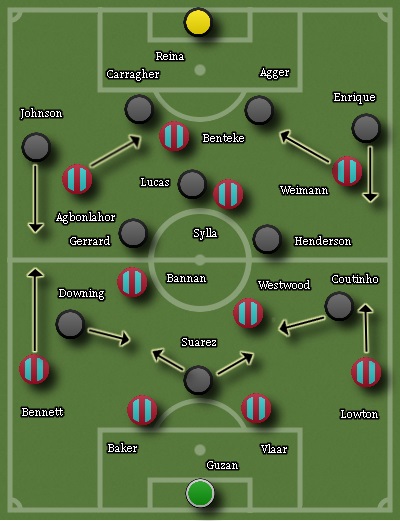By Mihail Vladimirov.
For the home team, Lambert had to make one change to the XI which won the last two games. In defence Clark had an arm injury so in came Bennett to play left back, with Baker moving alongside Vlaar. Interestingly though, Aston Villa’s formation was tweaked from 4-1-2-3 to more of a 4-2-1-3 with Sylla ahead of the two midfielders.
For Liverpool there were a few players coming back from injuries, with Reina, Carragher and Lucas all back in the starting lineup. Additionally Henderson was preferred to Sturridge, with the shape flipping its midfield triangle, hence coming back to the 4-1-2-3 outlook.
Starting strategies – the first half hour
Liverpool approached the game with their usual aim of passing the ball around and taking it from there going forward. This general aim was on paper boosted by having a 1-2 midfield triangle, capable of offering more passing angles from deep in order to calm the passing flow and gradually move the possession higher up. The front trio were all capable and willing to drop deep, join the build-up play and then interchange freely going forward. The full backs were playing as usual too, with Enrique initially holding his position deeper, offering an additional passing body before pushing forward, whilst Johnson tried to step forward earlier acting as the wide outlet who could receive the ball directly to instigate quick transition and play on the break.
So far so good – or at least nothing bad, so to speak. But once the home team’s strategy is taken into account it quickly becomes clear how the overall tactical landscape has been changed and Liverpool’s general idea hugely alternated and their tactical approach more or less ruined.
This article is for subscribers only.
[ttt-subscribe-article]
